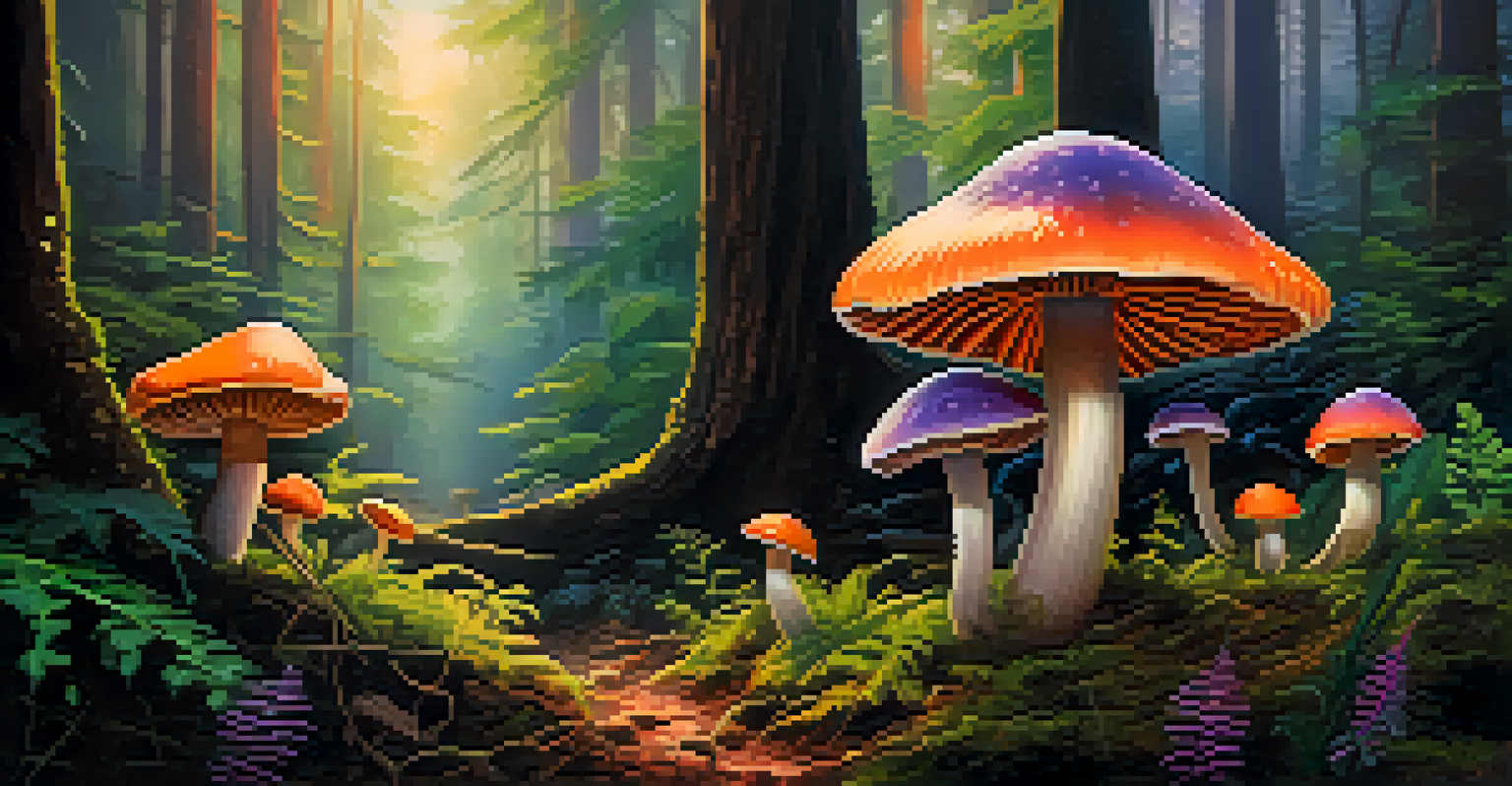Comparative Healing Practices of Ayahuasca and Psilocybin

Understanding Ayahuasca: A Traditional Healing Brew
Ayahuasca is a powerful plant-based brew traditionally used in South American shamanic practices. Made from the Banisteriopsis caapi vine and the Psychotria viridis leaf, it contains DMT, a potent psychedelic compound. This brew is often consumed in a ceremonial setting, guided by an experienced shaman who helps participants navigate their journey. The communal and spiritual aspects of Ayahuasca rituals foster a deep connection among participants, enhancing the healing experience.
The use of ayahuasca offers an opportunity to confront one’s demons, to embrace the shadows, and to transform them into light.
The healing effects of Ayahuasca can be profound, with many users reporting significant emotional and psychological breakthroughs. It has been used to treat a variety of issues, including depression, anxiety, and trauma. The experience often involves intense introspection and can lead to a greater understanding of oneself and one's place in the world. Many participants also describe feelings of connectedness to nature and others, which can be deeply healing.
However, it's essential to approach Ayahuasca with caution. The brew can provoke powerful psychological reactions, which may not be suitable for everyone. Those with certain medical conditions or mental health issues should consult with a healthcare professional before participating. This highlights the importance of guided practices and the need for a safe, supportive environment.
Exploring Psilocybin: The Magic Mushroom Experience
Psilocybin is the active compound found in certain species of mushrooms, commonly referred to as magic mushrooms. Like Ayahuasca, psilocybin induces altered states of consciousness, but it is generally consumed in a more informal setting. Users often prepare the mushrooms in various forms, such as dried, brewed in tea, or incorporated into foods. This flexibility makes psilocybin accessible to a broader audience.

The therapeutic potential of psilocybin has gained significant attention, particularly in recent years. Research has shown that it can help alleviate symptoms of depression, PTSD, and addiction. Users frequently report feelings of euphoria, enhanced creativity, and profound insights during their experience. The journey, while often intense, can lead to a sense of clarity and purpose that many find life-changing.
Ayahuasca's Healing Power
Ayahuasca facilitates profound emotional breakthroughs and connections to nature, often improving mental health conditions like depression and anxiety.
However, the experience can vary widely among individuals. Some may face challenging emotions or confront uncomfortable memories, which can be difficult to process. It’s essential for users to approach psilocybin with intention and, ideally, in a supportive setting. This highlights the importance of having a trusted guide or integration therapist to help navigate the experience.
Similarities in Healing: Connection and Introspection
Both Ayahuasca and psilocybin are known for their ability to facilitate deep introspection and emotional healing. They often allow users to confront past traumas and gain insights into their lives. This process can lead to significant personal growth and a shift in perspective, fostering a sense of clarity. The shared journey of self-discovery is a common thread that connects the two practices.
Psilocybin is a catalyst for personal growth and healing, allowing individuals to unlock deeper layers of self-awareness.
Moreover, both substances have been reported to enhance feelings of connection—to oneself, others, and the universe. Users frequently speak about experiencing unity with nature or a greater understanding of their relationships. This sense of connectedness can be profoundly healing, as it combats feelings of isolation and loneliness often associated with mental health issues. It’s this shared experience of oneness that many find transformative.
Despite their differing cultural backgrounds and methods of consumption, the overarching themes of healing through connection and introspection unify Ayahuasca and psilocybin. This makes them appealing options for individuals seeking alternative healing modalities. However, each practice has its unique nuances and should be approached with respect and mindfulness.
Cultural Context: Origins and Practices
Ayahuasca has deep roots in Amazonian cultures, where it has been used for centuries in spiritual and healing rituals. The involvement of shamans is crucial, as they provide guidance and support throughout the experience. These ceremonies often take place in natural settings, enhancing the connection to the environment. Understanding this cultural context is vital for appreciating the full significance of Ayahuasca's healing potential.
In contrast, the use of psilocybin mushrooms has a more diverse cultural history, with various indigenous groups utilizing them for spiritual purposes. In recent years, psilocybin has gained popularity in Western settings, often disconnected from its traditional roots. This shift raises important questions about the respectful use of these substances and the importance of honoring their origins. Recognizing the cultural significance of both practices can enhance the healing experience.
Psilocybin's Therapeutic Potential
Psilocybin mushrooms can induce altered states of consciousness that lead to significant insights, helping alleviate symptoms of PTSD, addiction, and depression.
As interest in these substances grows, it is essential to foster a respectful dialogue about their use. This includes understanding the traditional practices, the importance of consent, and the need for responsible consumption. By respecting the cultural backgrounds of both Ayahuasca and psilocybin, individuals can engage in a more meaningful and ethical exploration of their healing potential.
Safety Considerations: Risks and Precautions
When exploring the healing practices of Ayahuasca and psilocybin, safety should always be a top priority. Both substances can provoke intense psychological experiences that may not be suitable for everyone. Individuals with certain mental health conditions, such as schizophrenia or bipolar disorder, should exercise caution and seek professional advice before participating. Understanding one’s mental and physical health is crucial for a safe experience.
Moreover, the setting in which these substances are consumed plays a significant role in the overall experience. Ayahuasca is typically taken in a ceremonial context led by a trained shaman, which provides a structured environment. In contrast, psilocybin is often consumed in more casual settings, which can lead to varied experiences. Ensuring a safe, comfortable environment is essential for fostering positive outcomes, regardless of the substance used.
Lastly, being aware of potential interactions with medications is critical. Both Ayahuasca and psilocybin can interact negatively with certain pharmaceuticals, particularly antidepressants. Individuals should always disclose their medical history to healthcare professionals before engaging in these practices. By prioritizing safety and informed consent, users can enjoy a more beneficial and enriching healing journey.
Integration After the Experience: Moving Forward
Integration is a vital component of the healing journey after experiencing Ayahuasca or psilocybin. This process involves reflecting on the insights gained during the experience and finding ways to incorporate them into daily life. Many participants choose to work with therapists or join integration circles, where they can share their experiences and learn from others. This support can help individuals navigate the often-complex emotions that arise post-experience.
Additionally, journaling can be a powerful tool for integration. Writing down thoughts and reflections can aid in processing the experience and solidifying insights. This practice encourages mindfulness and helps individuals reconnect with their intentions. By documenting their journey, users can track their progress and growth over time, which can be incredibly empowering.
Safety and Integration Importance
Approaching Ayahuasca and psilocybin with caution, in safe settings, and focusing on integration post-experience is crucial for maximizing their healing benefits.
Ultimately, the integration process is an ongoing journey that can lead to lasting positive changes. By taking the time to reflect and incorporate lessons learned, individuals can cultivate a deeper understanding of themselves and their paths. This commitment to integration can enhance the overall healing potential of both Ayahuasca and psilocybin, allowing the benefits to extend far beyond the initial experience.
Conclusion: Embracing the Healing Potential
Both Ayahuasca and psilocybin offer unique pathways to healing, self-discovery, and transformation. While they stem from different cultural backgrounds, their ability to facilitate profound insights and emotional breakthroughs is remarkable. By understanding the similarities and differences between these practices, individuals can make informed choices about their healing journeys. This exploration can lead to a richer appreciation of the diverse ways we can heal and grow.
As we navigate the complexities of mental health and wellness, it's essential to remain open to alternative healing modalities. Ayahuasca and psilocybin represent just two options in a vast landscape of healing practices available today. The key lies in approaching these substances with respect, intention, and a commitment to safety. By integrating these experiences into our lives, we can harness their transformative potential.

In conclusion, whether drawn to the communal rituals of Ayahuasca or the personal journey of psilocybin, individuals have the opportunity to explore new dimensions of healing. As the conversation around these substances continues to evolve, we must prioritize ethical practices and cultural respect. Embracing the healing potential of Ayahuasca and psilocybin can lead to a deeper understanding of ourselves and our interconnectedness with the world around us.